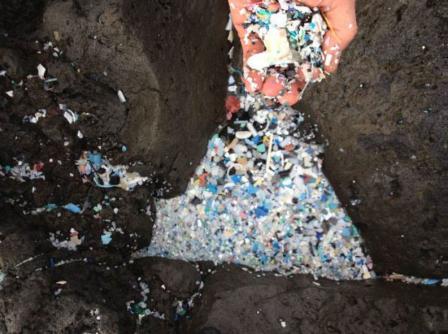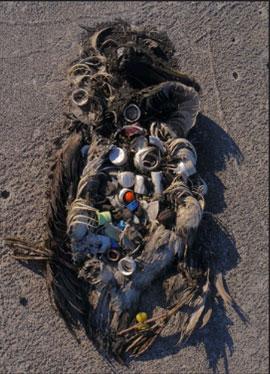Impacts of Mismanaged Trash
Trash can travel throughout the world's rivers and oceans, accumulating on beaches and within gyres. This debris harms physical habitats, transports chemical pollutants, threatens aquatic life, and interferes with human uses of river, marine and coastal environments.
Of all trash, plastic trash has the greatest potential to harm the environment, wildlife and humans. It can be found floating at the surface, suspended in the water column, or on the bottom of almost all water bodies. It is transported by rivers to the ocean, where it moves with the currents, and is often eaten by birds and fish, concentrating toxic chemicals in their tissues, and filling their stomachs, causing them to starve. Plastic aquatic debris is much more than a mere aesthetic problem.
On this page:
- Habitat Impacts
- Chemical Impacts
- Biological Impacts
- Problems Associated with Ingestion of Plastic Particles
- Human Impacts
Habitat Impacts
The term benthic refers to anything associated with or occurring on the bottom of a body of water such as a river, lake or ocean. The animals and plants that live on or in the bottom are known as the benthos.
Habitat alteration is caused by trash and debris in rivers and oceanic convergence (accumulation) zones, on beaches, and submerged benthic (at and near the bottom of rivers and oceans) habitats. As debris accumulates, habitat structure may be modified, light levels may be reduced in underlying waters, and oxygen levels may be depleted. These changes can undermine the ability of open water and benthic habitats to support aquatic life.
 As benthic habitat-forming species decline and as the physical structure of the habitats are modified, there may be indirect impacts of marine debris such as declines in species that are dependent on these habitats for foraging and shelter. For example, degradation of coral reefs globally has the potential to undermine the survival of a diverse array of invertebrates, fish, and vertebrates that depend on this limited resource, including many threatened and endangered species.
As benthic habitat-forming species decline and as the physical structure of the habitats are modified, there may be indirect impacts of marine debris such as declines in species that are dependent on these habitats for foraging and shelter. For example, degradation of coral reefs globally has the potential to undermine the survival of a diverse array of invertebrates, fish, and vertebrates that depend on this limited resource, including many threatened and endangered species.
Chemical Impacts
Chemical impacts associated with plastic aquatic trash include the accumulation and transport of persistent, bioaccumulative and toxic (PBTs) contaminants, such as PCBs and pesticides. Aquatic plastic debris has been found to accumulate contaminants at concentrations that are orders of magnitude (thousands to millions of times) greater than the surrounding environment. Based on a number of studies, including those conducted by EPA, plastics have the potential to adsorb chemicals of concern from the environment, and serve as a potential global transport mechanism for contaminants of concern into the food chain and potentially to humans who eat seafoods.
Contaminants accumulated on the surface of plastic particles as well as those within the plastic can be released to the environment when the plastics break down into smaller particles as a result of ultraviolet (UV) radiation, mechanical forces, and weathering. Evidence is adding up that plastic debris, including resin pellets and fragments, transfer PBTs to organisms when consumed. For example, the accumulation of PBTs from plastics has been documented in seabirds and benthic organisms. In a study by Ryan et al (1988), great shearwaters (Puffinus gravis), a seabird known to ingest plastic, had PCB concentrations in fat tissues corresponding to the amounts of plastic found in their stomachs.
Biological Impacts
There is a substantial body of evidence documenting the harmful effects of aquatic plastic debris on river and marine organisms. It has been estimated that plastic marine debris adversely affects at least 267 species globally, including 86% of sea turtles, 44% of seabirds, and 43% of marine mammals. The most common threats to wildlife include both physical hazards from ingestion and entanglement, and toxicological threats from ingestion of contaminants attached to and trapped within plastic particles. EPA's Clean Water Act and Superfund (CERCLA) programs have tools we can use to reduce the threats from these contaminants.
Problems Associated with Ingestion of Plastic Particles
 Problems associated with the ingestion of plastics include development of internal and external wounds, impairment of feeding capacity due to the buildup or blockage of the digestive system, decreased mobility and predatory avoidance, and toxicity. Ingestion of plastics by seabirds has been shown to reduce body weight, inhibit fat deposition, and reduce reproductive capacity. Due to the fact that seabirds feed over wide ranges and are an upper-trophic level predator (that is, they eat prey high on the food chain), they act as early indicators of pollutants such as plastics in the marine environment.
Problems associated with the ingestion of plastics include development of internal and external wounds, impairment of feeding capacity due to the buildup or blockage of the digestive system, decreased mobility and predatory avoidance, and toxicity. Ingestion of plastics by seabirds has been shown to reduce body weight, inhibit fat deposition, and reduce reproductive capacity. Due to the fact that seabirds feed over wide ranges and are an upper-trophic level predator (that is, they eat prey high on the food chain), they act as early indicators of pollutants such as plastics in the marine environment.
Ingestion of plastic debris by seabirds, fish, and sea turtles has been widely documented, and ingestion has been reported from marine mammals as well. The potential for plastic ingestion is largely associated with situations where plastic particles can be mistaken for food. For example, sea turtles readily consume plastic bags and other floating debris that appear similar to their gelatinous prey, jellyfish. Predatory organisms, such as fur seals, may indirectly consume plastics through consumption of ocean fish and other prey that have consumed plastic particles mistaken for food.
Human Impacts
 In addition to degrading the habitats and ecosystem services that humans use, plastic aquatic debris can directly interfere with navigation, impede commercial and recreational fishing, threaten health and safety, and reduce tourism. Large debris, such as derelict fishing nets and lines that float at or just below the surface, pose the greatest threat to vessel navigation. Lines and nets can become wrapped around propellers and entrained in intakes of motors, and vessels may strike large items, damaging hulls and propellers.
In addition to degrading the habitats and ecosystem services that humans use, plastic aquatic debris can directly interfere with navigation, impede commercial and recreational fishing, threaten health and safety, and reduce tourism. Large debris, such as derelict fishing nets and lines that float at or just below the surface, pose the greatest threat to vessel navigation. Lines and nets can become wrapped around propellers and entrained in intakes of motors, and vessels may strike large items, damaging hulls and propellers.
Additionally, "ghost fishing" by lost, drifting nets and pots can kill fish and invertebrates valuable to local commercial and recreational fisheries. It was estimated that derelict crab pots capture approximately 200,000 pounds of Dungeness crab in Puget Sound annually. Ghost fishing can compete with active fishing for limited resources, undermining economic opportunities while also decreasing the reproductive capacities of fish and invertebrate stocks.
Immobilization of commercial and recreational vessels can result in increased costs of navigation due to lost time, costly repairs, as well as the loss of human life. In a tragic example, derelict fishing gear contributed to the sinking of a Korean passenger ferry in 1993 that resulted in the deaths of 292 passengers.
The results of the 2012 EPA study show that these West Coast communities, regardless of their size, spend an annual average $13 per resident to control litter and reduce marine debris.
Humans can also be directly harmed by aquatic trash, becoming entangled in nets and lines while swimming or diving, or being injured by sharp debris that accumulates on beaches. It is not uncommon for SCUBA divers to become entangled in nets or lines. In most instances they are able to free themselves. In rare instances entanglement has resulted in injury and even death. Additionally, sharp debris that accumulates on beaches regularly results in puncture wounds and lacerations. Medical waste, such as hypodermic needles, is of particular concern because punctures can result in the transfer of infections and disease. Due to the human health risk of medical debris, beaches in New York and New Jersey were closed to protect the public from medical waste that washed ashore in 1988. It was estimated that the loss of revenue from beach closures in 1988 to New Jersey alone was in the range of $706 million to nearly $3 billion.
Aquatic trash also reduces the aesthetic and recreational values of rivers, beaches and marine resources. The buildup of plastic debris on beaches is of particular concern for coastal cities since unsightly debris and entangled marine life can reduce the area's attractiveness to local residents and tourists. Immense economic costs are incurred to clean marine debris from beaches. In 2012 EPA conducted a study to quantify the cost spent by 90 cities, large and small, in California, Oregon and Washington, located along the coast or in watersheds draining to the ocean, to clean up litter and prevent trash from entering the ocean or waterways leading to it. Nearly 50 million people live in these three states and over 85 percent of them live on the ocean or along rivers draining into it. West Coast communities are spending more than $520 million dollars a year to combat litter and prevent trash from becoming marine debris. This public cost burden makes yet another reason for finding effective strategies to reduce the trash entering our waterways and contributing to marine debris.
